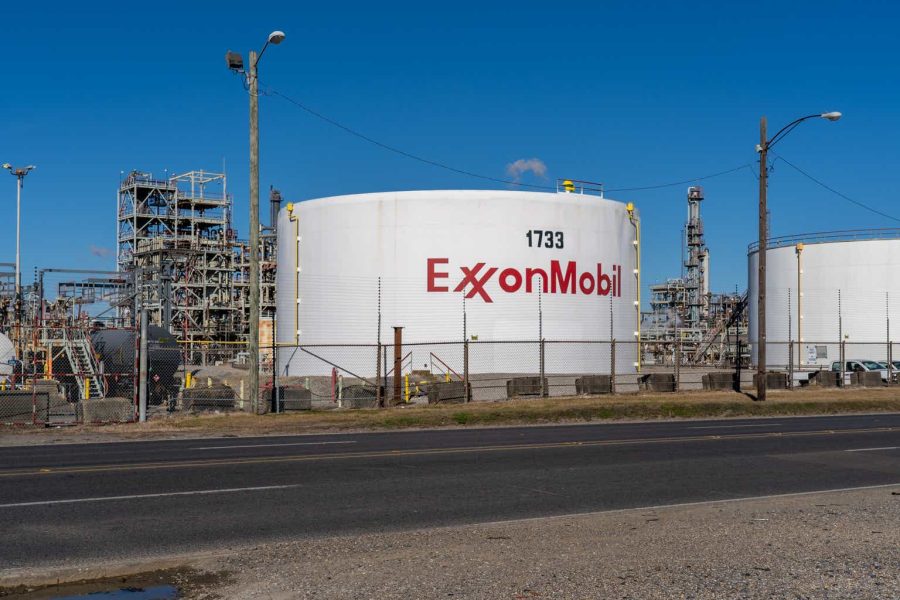July 14, 2024 This Week Top S&P 500 Gainers & Losers
Tesla Q2: The Bottom Is Likely In
Tesla: Time To Take Profits
Microsoft: The Q4 Results Should Surprise You
Tesla: Optimus And FSD Probably Won’t Save The Day
April 23, 2024 Maximizing Profits: When is the Right Time to Sell Your Business?
April 12, 2024 Improve Your Financial Status: A How-To Guide
April 12, 2024 How ZIM Integrated Container Tracking is Revolutionizing Global Trade
March 15, 2024 6 Best Growth Stocks To Buy Now According to Metatrader 5

Exxon Mobil (XOM) Stock Forecast for 2024–2028. Sell or Buy?
Updated: July 27, 2024 (04:06)
Sector: EnergyThe share price of Exxon Mobil Corp. (XOM) now
50/200 Day Moving Average: $114.24 / $109.18
This figure corresponds to the Average Price over the previous 50/200 days. For Exxon Mobil stocks, the 50-day moving average is the support level today.
For Exxon Mobil stocks, the 200-day moving average is the support level today.
Are you interested in Exxon Mobil Corp. stocks and want to buy them, or are they already in your portfolio? If yes, then on this page you will find useful information about the dynamics of the Exxon Mobil stock price in 2024, 2025, 2026, 2027, 2028. How much will one Exxon Mobil share be worth in 2024 - 2028?
When should I take profit in Exxon Mobil stock? When should I record a loss on Exxon Mobil stock? What are analysts' forecasts for Exxon Mobil stock? What is the future of Exxon Mobil stock? We forecast Exxon Mobil stock performance using neural networks based on historical data on Exxon Mobil stocks. Also, when forecasting, technical analysis tools are used, world geopolitical and news factors are taken into account.
Exxon Mobil stock prediction results are shown below and presented in the form of graphs, tables and text information, divided into time intervals. (Next month, 2024, 2025, 2026, 2027 and 2028) The final quotes of the instrument at the close of the previous trading day are a signal to adjust the forecasts for Exxon Mobil shares. This happens once a day.
Historical and forecast chart of Exxon Mobil stock
The chart below shows the historical price of Exxon Mobil stock and a prediction chart for the next month. For convenience, prices are divided by color. Forecast prices include: Optimistic Forecast, Pessimistic Forecast, and Weighted Average Best Forecast. Detailed values for the Exxon Mobil stock price can be found in the table below.
Long-term forecasts by years.

Forecasting Exxon Mobil (XOM) Stock Rates: Key Factors to Watch

Exxon Mobil (XOM) stocks have been a focal point for investors, and various factors in the near future will significantly influence their rate changes. Analysts keen on making the most accurate predictions need to delve into these dynamics thoroughly. Here, we highlight the pivotal drivers impacting XOM stock forecasts.
Key Factors Influencing XOM Stock Rate
Higher oil prices are at the forefront, as they directly augment Exxon Mobil's revenue and profitability. With predictions suggesting oil prices could rise to $115 per barrel due to geopolitical tensions, OPEC production cuts, and inflation, each dollar increase in oil prices could remarkably boost XOM’s earnings per share (EPS) by approximately $0.21.
The acquisition of Pioneer Natural Resources is another critical factor. This strategic move is expected to double Exxon’s presence in the Permian Basin, contributing to increased production volumes and lower costs. These enhancements could lead to significant profitability, driving up XOM stock prices.
- Margin Recovery: Improvement in operating margins from 9.07% to 12.33% in 2024 highlights better cost management and efficiency.
- Attractive Valuation Multiples: A current FWD P/E ratio of 13.08, lower than its historical average, positions XOM as a potentially undervalued stock, drawing investor interest.
- Robust Capital Return Programs: Substantial dividends and share repurchases fortify investor confidence, enhancing stock value.
- Geopolitical and Operational Risks: While mainly potential downsides, geopolitical instability and integration challenges with Pioneer could disrupt operations and impact stock performance.
Analysts can leverage these insights on higher oil prices, strategic acquisitions, and valuation multiples to forecast XOM stock prices effectively. By monitoring these indicators and understanding their potential impacts, forecasts on the Exxon Mobil stock rate can be more precise and informed.
In summary, the interplay of these factors will be critical in shaping the future trajectory of XOM stock prices. For investors wondering if XOM stock is a buy or sell, keeping a keen eye on these developments will provide strategic insights into their stock price predictions and targets.
Review the original Analysis

Deciphering the Future of XOM Stocks: An Analysis of Exxon Mobil's Prospects

With the ever-evolving landscape of the energy sector, investors and analysts are closely watching Exxon Mobil (XOM), seeking to understand what the future holds for its stock price. A myriad of factors are poised to influence XOM stock rates, making an accurate forecast both challenging and essential for investment decisions.
Key Drivers Influencing XOM Stock Predictions
The balance of the oil market is expected to be a significant determinant of XOM's financial performance. With the potential shift from a tight supply to a surplus, analysts are bracing for the implications on oil prices—and by extension—XOM's profitability. This is crucial for those pondering whether XOM stock is a buy or sell. Additionally, the gas market outlook, particularly the strong demand emerging from Asia, promises to be a double-edged sword. While it offers a venue for revenue growth, fluctuations in European demand and prices could temper expectations.
Understanding the revenue structure and segment performance of Exxon Mobil reveals that its Energy Products segment is a vital revenue stream. Moreover, the deal with Pioneer Natural Resources stands out as a pivotal event. By potentially enhancing XOM's production capacity and reducing costs, this merger is widely viewed as a catalyst that could elevate the company's stock price. Therefore, for an analyst aiming to make the most accurate XOM stock forecast, dissecting these factors becomes paramount.
These elements not only shape the Exxon Mobil stock forecast but also guide investors in determining if XOM is a good stock to buy. By closely monitoring changes in the oil and gas markets, combined with the strategic impacts of recent corporate deals, analysts can offer well-informed XOM stock price predictions, making the task of deciding to buy or sell Exxon Mobil stock significantly more straightforward.
Review the original Analysis

Unveiling the Future of Exxon Mobil: A Deep Dive into Stock Predictions

As we stand on the verge of pivotal movements within the energy sector, the Exxon Mobil Corporation (XOM) finds itself under the microscope of discerning investors. In order to discern the future trajectory of XOM stock prices, a comprehensive look at certain critical elements is essential. Principal among these is the lucrative Guyana Partnership, which has demonstrated record-breaking margins and stands as a significant pillar supporting XOM stock forecasts. Analysts and investors marvel at the possibility of this partnership contributing to half of Exxon Mobil's entire production output. This singular factor alone propels the profitability expectations to new heights, urging a bullish sentiment towards XOM stock buy or sell decisions.
Key Catalysts Shaping XOM Stock Value
Beyond the glaring promise of the Guyana Partnership, Exxon Mobil's strategic focus on Competitive Advantaged Assets, notably within the Guyana sphere, serves as a stronghold in safeguarding its market position and financial resilience. This adept allocation of resources towards cost-efficient assets crystallizes the company's trajectory towards doubling earnings by 2027, making the question of whether XOM is a good stock to buy seemingly more favorable.
Moreover, the relentless pursuit of Exploration and Discovery forms the bedrock of Exxon Mobil’s future-proofing strategy. Acknowledging the inherent risks and extended timelines characteristic of the oil and gas exploration sector, Exxon Mobil’s track record of successful discoveries, such as offshore Guyana, offers a glimmer of predictability in the otherwise volatile energy market. It’s these discoveries that reinforce investor confidence and feed into the broader Exxon Mobil stock forecast narrative.
In the complex tapestry of factors influencing Exxon Mobil’s future earnings and stock prices, analyzing these dimensions offers a compass for anticipating the movement of XOM stock rates. Leveraging these insights, analysts are better positioned to deliver accurate XOM stock price predictions, ultimately guiding investors towards judicious buy or sell decisions in the energy domain.
- Guyana Partnership Profitability
- Competitive Advantaged Assets
- Exploration and Discovery
In conclusion, while the terrain is fraught with uncertainties, a well-rounded interpretation of these factors presents a formidable toolkit for demystifying XOM stock price targets. As Exxon Mobil continues to galvanize its operations around these strategic pillars, the future certainly looks promising for those holding or considering an investment in XOM stocks.
Review the original Analysis
Exxon Mobil Corporation is an American company, one of the largest oil companies in the world, one of the largest corporations in the world in terms of market capitalization. The company is headquartered in Irving, a suburb of Dallas, Texas. The main reserves of oil are located in Asia and the USA, natural gas – in the USA, Australia, Asia and Europe.
Exxon Mobil daily forecast for a month
| Date | Target | Pes. | Opt. | Vol., % |
|---|---|---|---|---|
| Jul 29 | 119.14 | 118.42 | 120.23 | 1.53 |
| Jul 30 | 118.59 | 117.50 | 119.73 | 1.90 |
| Jul 31 | 118.59 | 117.59 | 120.20 | 2.22 |
| Aug 01 | 117.88 | 116.46 | 119.53 | 2.63 |
| Aug 02 | 119.58 | 118.07 | 120.49 | 2.05 |
| Aug 03 | 118.88 | 117.48 | 119.81 | 1.98 |
| Aug 04 | 119.98 | 118.37 | 121.39 | 2.55 |
| Aug 05 | 120.98 | 119.41 | 122.51 | 2.59 |
| Aug 06 | 121.57 | 121.08 | 122.29 | 1.00 |
| Aug 07 | 120.18 | 119.31 | 121.43 | 1.77 |
| Aug 08 | 118.74 | 117.95 | 119.90 | 1.65 |
| Aug 09 | 119.28 | 118.78 | 120.50 | 1.45 |
| Aug 10 | 121.65 | 119.72 | 123.37 | 3.05 |
| Aug 11 | 120.70 | 119.03 | 121.93 | 2.43 |
| Aug 12 | 122.75 | 120.81 | 123.78 | 2.46 |
| Aug 13 | 123.90 | 122.09 | 125.76 | 3.00 |
| Aug 14 | 125.66 | 124.33 | 126.67 | 1.88 |
| Aug 15 | 127.62 | 126.75 | 128.13 | 1.09 |
| Aug 16 | 128.49 | 127.85 | 130.55 | 2.11 |
| Aug 17 | 126.49 | 125.88 | 127.83 | 1.55 |
| Aug 18 | 126.69 | 124.94 | 128.39 | 2.76 |
| Aug 19 | 127.93 | 127.16 | 129.00 | 1.45 |
| Aug 20 | 130.13 | 128.28 | 130.94 | 2.07 |
| Aug 21 | 129.40 | 127.64 | 131.21 | 2.80 |
| Aug 22 | 130.23 | 128.28 | 131.19 | 2.27 |
| Aug 23 | 130.39 | 128.85 | 131.04 | 1.70 |
| Aug 24 | 131.30 | 130.17 | 132.01 | 1.41 |
| Aug 25 | 129.83 | 129.23 | 131.83 | 2.01 |
| Aug 26 | 129.85 | 128.89 | 131.46 | 1.99 |
| Aug 27 | 130.89 | 129.87 | 131.63 | 1.35 |
Exxon Mobil Daily Price Targets
Exxon Mobil Stock Forecast 07-29-2024.
Forecast target price for 07-29-2024: $119.14.
Positive dynamics for Exxon Mobil shares will prevail with possible volatility of 1.506%.
Pessimistic target level: 118.42
Optimistic target level: 120.23
Exxon Mobil Stock Forecast 07-30-2024.
Forecast target price for 07-30-2024: $118.59.
Negative dynamics for Exxon Mobil shares will prevail with possible volatility of 1.863%.
Pessimistic target level: 117.50
Optimistic target level: 119.73
Exxon Mobil Stock Forecast 07-31-2024.
Forecast target price for 07-31-2024: $118.59.
Negative dynamics for Exxon Mobil shares will prevail with possible volatility of 2.170%.
Pessimistic target level: 117.59
Optimistic target level: 120.20
Exxon Mobil Stock Forecast 08-01-2024.
Forecast target price for 08-01-2024: $117.88.
Negative dynamics for Exxon Mobil shares will prevail with possible volatility of 2.564%.
Pessimistic target level: 116.46
Optimistic target level: 119.53
Exxon Mobil Stock Forecast 08-02-2024.
Forecast target price for 08-02-2024: $119.58.
Positive dynamics for Exxon Mobil shares will prevail with possible volatility of 2.005%.
Pessimistic target level: 118.07
Optimistic target level: 120.49
Exxon Mobil Stock Forecast 08-03-2024.
Forecast target price for 08-03-2024: $118.88.
Negative dynamics for Exxon Mobil shares will prevail with possible volatility of 1.945%.
Pessimistic target level: 117.48
Optimistic target level: 119.81
XOM (XOM) Monthly Stock Prediction for 2024
| Month | Target | Pes. | Opt. | Vol., % |
|---|---|---|---|---|
| Aug. | 112.54 | 111.24 | 115.24 | 3.47 |
| Sep. | 115.97 | 114.81 | 119.33 | 3.79 |
| Oct. | 118.29 | 117.05 | 121.60 | 3.75 |
| Nov. | 114.68 | 110.61 | 117.49 | 5.86 |
| Dec. | 114.80 | 112.67 | 116.40 | 3.21 |
Exxon Mobil forecast for this year
Exxon Mobil Stock Prediction for Aug 2024
An downtrend is forecast for this month with an optimal target price of $112.537. Pessimistic: $111.24. Optimistic: $115.24
Exxon Mobil Stock Prediction for Sep 2024
An uptrend is forecast for this month with an optimal target price of $115.97. Pessimistic: $114.81. Optimistic: $119.33
Exxon Mobil Stock Prediction for Oct 2024
An uptrend is forecast for this month with an optimal target price of $118.289. Pessimistic: $117.05. Optimistic: $121.60
Exxon Mobil Stock Prediction for Nov 2024
An downtrend is forecast for this month with an optimal target price of $114.681. Pessimistic: $110.61. Optimistic: $117.49
Exxon Mobil Stock Prediction for Dec 2024
An uptrend is forecast for this month with an optimal target price of $114.796. Pessimistic: $112.67. Optimistic: $116.40
Exxon Mobil (XOM) Monthly Stock Prediction for 2025
| Month | Target | Pes. | Opt. | Vol., % |
|---|---|---|---|---|
| Jan | 116.17 | 114.49 | 117.51 | 2.57 |
| Feb | 121.17 | 117.59 | 124.74 | 5.73 |
| Mar | 118.93 | 117.50 | 123.15 | 4.59 |
| Apr | 117.62 | 113.68 | 120.09 | 5.34 |
| May | 119.56 | 114.78 | 121.23 | 5.33 |
| Jun | 122.07 | 119.20 | 125.92 | 5.33 |
| Jul | 121.09 | 118.73 | 123.33 | 3.73 |
| Aug | 119.88 | 116.41 | 121.74 | 4.38 |
| Sep | 121.26 | 119.20 | 123.57 | 3.53 |
| Oct | 118.29 | 116.40 | 119.83 | 2.86 |
| Nov | 117.17 | 114.59 | 119.22 | 3.88 |
| Dec | 121.33 | 117.57 | 124.66 | 5.69 |
Exxon Mobil (XOM) Monthly Stock Prediction for 2026
| Month | Target | Pes. | Opt. | Vol., % |
|---|---|---|---|---|
| Jan | 124.54 | 120.12 | 127.90 | 6.09 |
| Feb | 125.66 | 121.20 | 128.55 | 5.72 |
| Mar | 121.08 | 116.72 | 124.53 | 6.27 |
| Apr | 119.38 | 116.81 | 123.92 | 5.73 |
| May | 121.29 | 119.96 | 123.35 | 2.75 |
| Jun | 124.26 | 120.91 | 127.87 | 5.44 |
| Jul | 126.69 | 122.38 | 131.18 | 6.71 |
| Aug | 132.13 | 128.57 | 137.42 | 6.44 |
| Sep | 136.49 | 132.81 | 138.40 | 4.04 |
| Oct | 139.29 | 136.85 | 142.15 | 3.72 |
| Nov | 135.25 | 133.36 | 137.96 | 3.33 |
| Dec | 131.13 | 126.67 | 132.44 | 4.36 |
Exxon Mobil (XOM) Monthly Stock Prediction for 2027
| Month | Target | Pes. | Opt. | Vol., % |
|---|---|---|---|---|
| Jan | 125.49 | 123.79 | 127.62 | 3.00 |
| Feb | 125.61 | 123.29 | 128.32 | 3.92 |
| Mar | 128.69 | 125.28 | 133.65 | 6.26 |
| Apr | 128.95 | 125.34 | 133.91 | 6.40 |
| May | 126.37 | 122.33 | 130.86 | 6.52 |
| Jun | 127.95 | 124.69 | 131.85 | 5.43 |
| Jul | 132.62 | 130.70 | 137.66 | 5.06 |
| Aug | 129.77 | 127.24 | 134.51 | 5.40 |
| Sep | 130.55 | 127.41 | 134.46 | 5.24 |
| Oct | 134.20 | 132.39 | 137.89 | 3.99 |
| Nov | 132.79 | 131.40 | 134.79 | 2.51 |
| Dec | 132.26 | 129.42 | 136.63 | 5.28 |
Exxon Mobil (XOM) Monthly Stock Prediction for 2028
| Month | Target | Pes. | Opt. | Vol., % |
|---|---|---|---|---|
| Jan | 132.59 | 131.20 | 137.50 | 4.58 |
| Feb | 135.44 | 131.79 | 138.36 | 4.75 |
| Mar | 138.29 | 135.25 | 141.54 | 4.45 |
| Apr | 141.12 | 135.69 | 143.10 | 5.18 |
| May | 142.39 | 138.26 | 144.24 | 4.15 |
| Jun | 144.32 | 142.87 | 145.76 | 1.98 |
| Jul | 151.46 | 149.11 | 153.88 | 3.10 |
| Aug | 148.58 | 146.06 | 150.22 | 2.77 |
| Sep | 146.13 | 140.80 | 151.32 | 6.95 |
| Oct | 151.98 | 145.90 | 155.24 | 6.02 |
| Nov | 155.39 | 153.30 | 160.37 | 4.41 |
| Dec | 157.34 | 154.58 | 163.00 | 5.16 |
Exxon Mobil information and performance
5959 LAS COLINAS BLVD, IRVING, TX, US
Market capitalization of the Exxon Mobil Corp. is the total market value of all issued shares of a company. It is calculated by the formula multiplying the number of XOM shares in the company outstanding by the market price of one share.
EBITDA of Exxon Mobil is earnings before interest, income tax and depreciation of assets.
P/E ratio (price to earnings) - shows the ratio between the price of a share and the company's profit
Price/earnings to growth
Dividend Per Share is a financial indicator equal to the ratio of the company's net profit available for distribution to the annual average of ordinary shares.
Dividend yield is a ratio that shows how much a company pays in dividends each year at the stock price.
EPS shows how much of the net profit is accounted for by the common share.
Trailing P/E depends on what has already been done. It uses the current share price and divides it by the total earnings per share for the last 12 months.
Forward P/E uses projections of future earnings instead of final numbers.
Enterprise Value (EV) /Revenue
The EV / EBITDA ratio shows the ratio of the cost (EV) to its profit before tax, interest and amortization (EBITDA).
Number of issued ordinary shares
Number of freely tradable shares
Shares Short Prior Month - the number of shares in short positions in the last month.
Exxon Mobil (XOM) stock dividend
Exxon Mobil last paid dividends on 05/14/2024. The next scheduled payment will be on 06/10/2024. The amount of dividends is $3.72 per share. If the date of the next dividend payment has not been updated, it means that the issuer has not yet announced the exact payment. As soon as information becomes available, we will immediately update the data. Bookmark our portal to stay updated.
Last Split Date: 01/01/1970
Splitting of shares is an increase in the number of securities of the issuing company circulating on the market due to a decrease in their value at constant capitalization.
For example, a 5: 1 ratio means that the value of one share will decrease 5 times, the total amount will increase 5 times. It is important to understand that this procedure does not change the capitalization of the company, as well as the total value of assets held in private hands.














































